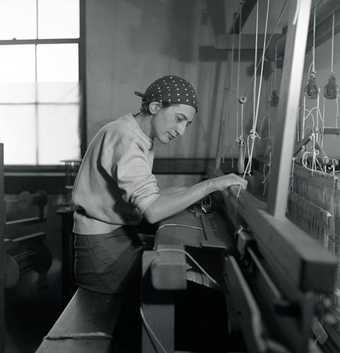
Anni Albers Card Weaving at Black Mountain College Black Mountain College Photograph Collection, State Archives of North Carolina, Western Regional Archives, Asheville, N.C.
Anni Albers was a German artist. She was born in Berlin in 1899 and came from a Jewish family. She was interested in art from a young age.
Albers studied at the Bauhaus. The Bauhaus was an exciting school of art and design in Germany. Art teachers and students at the school worked and learnt together instead of being told what to do. That’s right! We wish we could study there too!
At the time, women were only allowed to study a few classes. Anni decided to study weaving and became one of the greatest textile artists of our time. She believed that textiles are a type of art and as important as painting or sculpture! How does it make you feel that women weren't allowed to the study the same things as men? Can you think of any example of unfair things happening to women today?
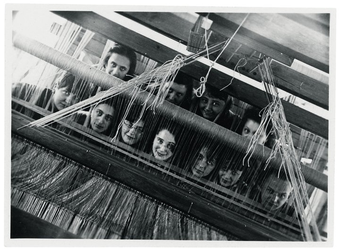
Life at the Bauhaus, 1928 Photographer unknown
Anni Albers was interested in old methods of weaving. She used looms to make many of her textile designs. A loom is a piece of equipment used to make fabrics. It weaves threads over and under other threads to create the textile. People have used looms for a long time. There are different kinds and shapes of looms and Albers usually used a large one to hand-weave her fabrics. Here she is looking through a loom! Can you spot the thread?
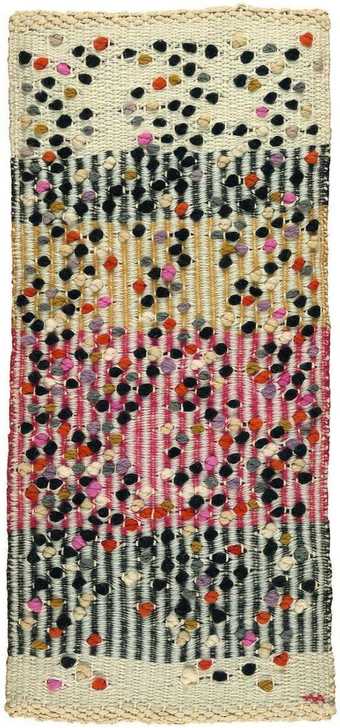
Anni Albers Dotted 1959 Museum of Fine Arts Boston. The Daphne Farago Collection © 2018 The Josef and Anni Albers Foundation/Artists Rights Society (ARS), New York/DACS, London
Photo Courtesy, Museum of Fine Arts, Boston
In the artwork Dotted, Anni Albers used lots of different coloured threads. Pink, black, dark green and beige. The colours and patterns in Albers’s works can remind us of many different things. For example, colours used in Dotted can look like a scene in autumn. Can you think of an everyday object that reminds you of a season? Can you choose three colours which remind you of summer?
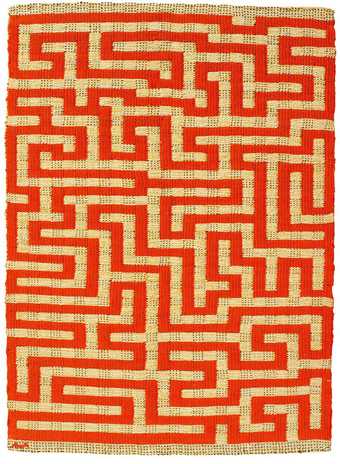
Anni Albers Red Meander 1954 Private Collection © 2018 The Josef and Anni Albers Foundation/Artists Rights Society (ARS), New York/DACS, London
Anni Albers moved to the United States of America in 1933. Travelling was a very important part of her life and she learnt a lot by going to different places. After moving to America, she made a lot of trips to South America. She loved old textile works from countries such as Peru and Mexico and was interested in their ancient textile traditions. At the beginning of one of her book On Weaving, Albers wrote:
To my great teachers, the weavers of ancient Peru.
In the artwork Red Meander, Albers tried to remake the patterns of an ancient labyrinth. This artwork feels very mysterious and magical. Have you ever been to a maze? Can you try and solve the maze in Red Meander?
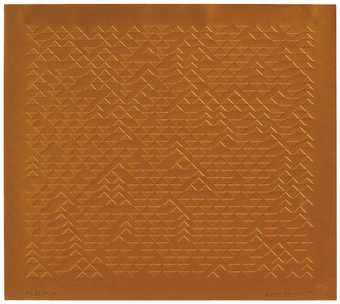
Anni Albers TR III 1969-70 Screen print on paper Tate © 2018 The Josef and Anni Albers Foundation/Artists Rights Society (ARS), New York/DACS, London
Anni Albers thought that people had forgotten about their sense of touch. Today, a lot of objects are made by machines. This means that we don’t have to use our hands as much as we used to. She liked to make artworks that tickle our sense of touch and make us want to feel them.
Look at artwork TR III. Some of the triangles are raised. Others are flat on the surface of the fabric. Don't they look like little mountains? How about lots of small pyramids?
Look around you. Can you see any interesting patterns? Try and design a pattern for a piece of textile. Or learn how to weave your own friendship bracelet.

